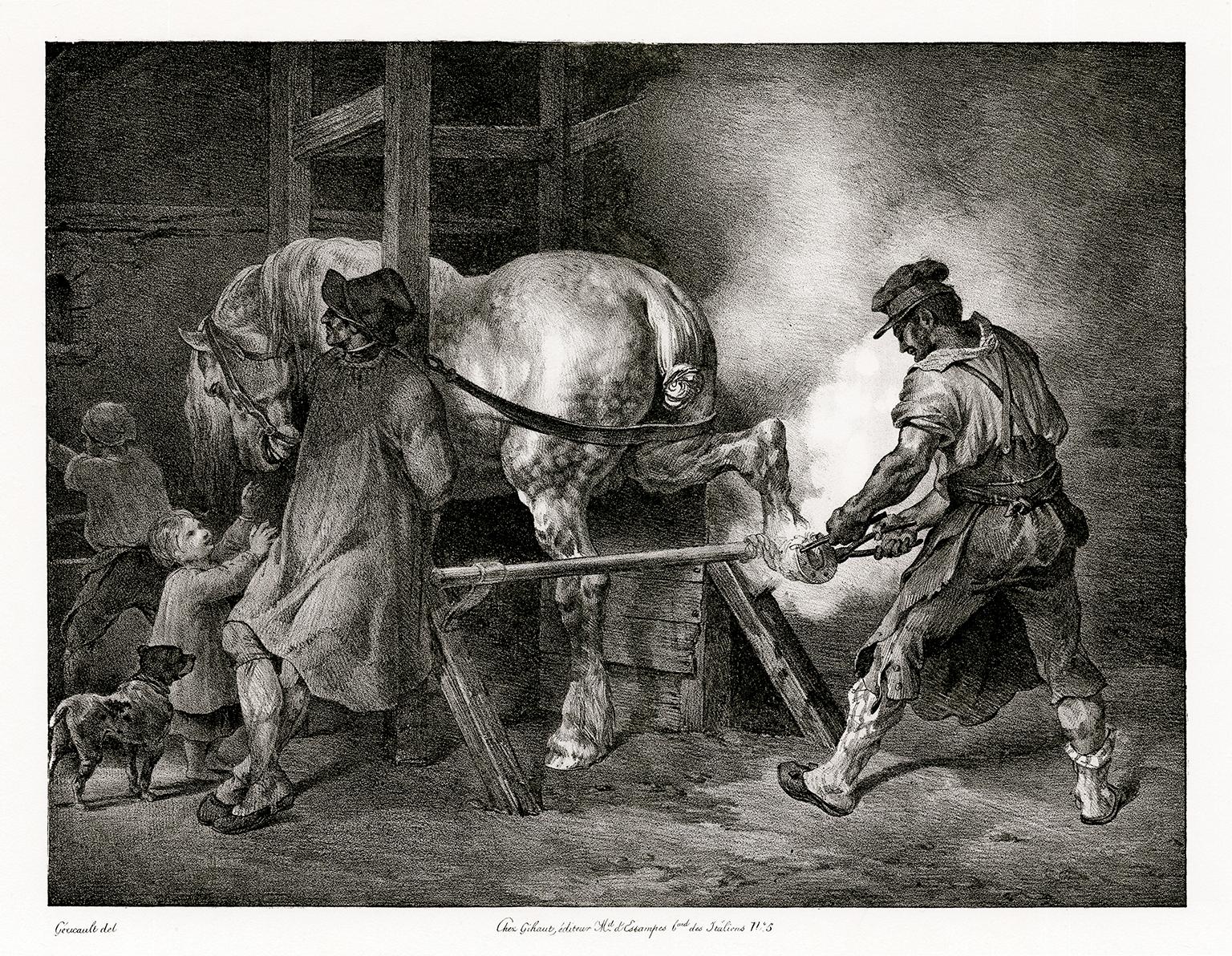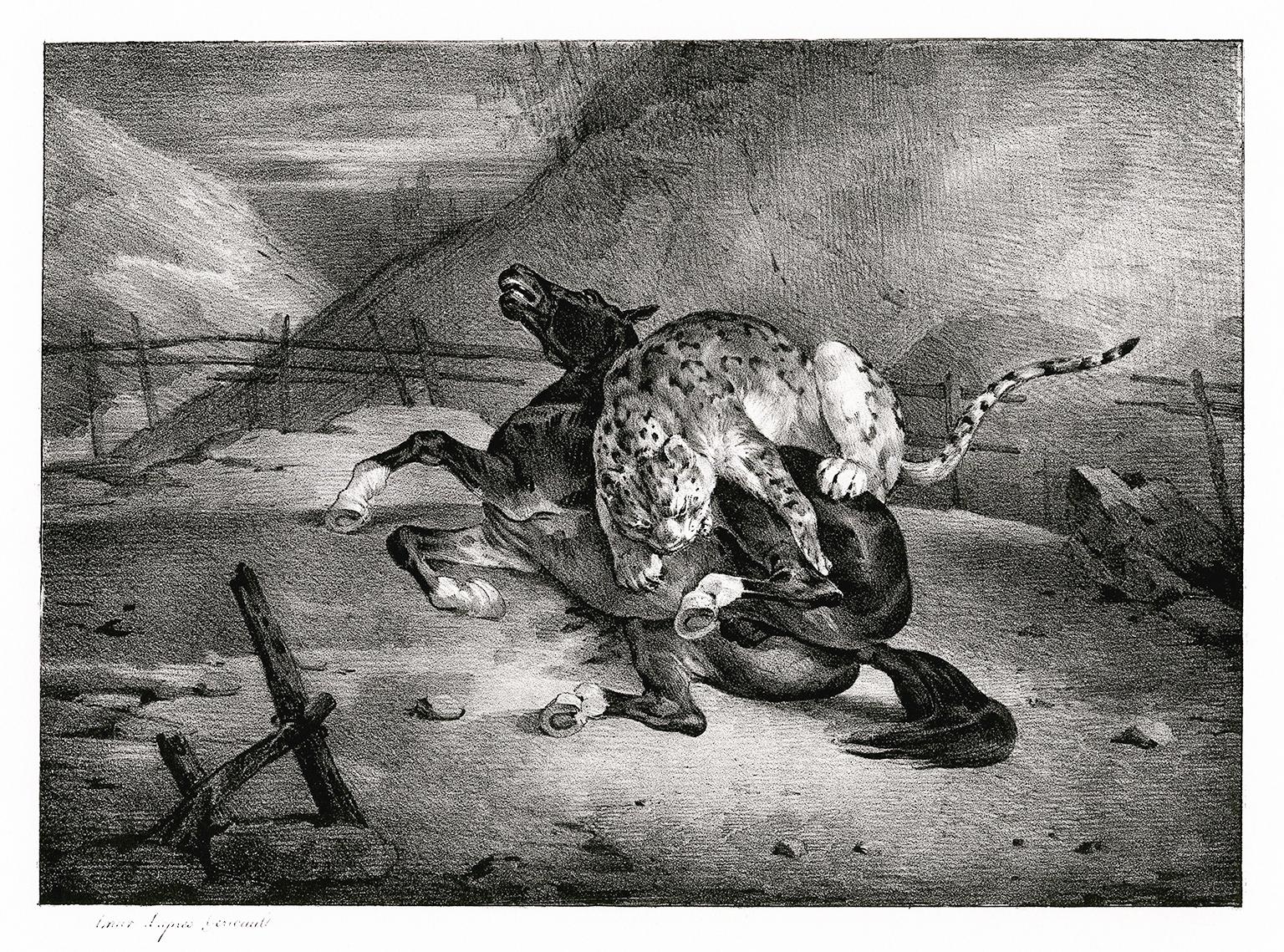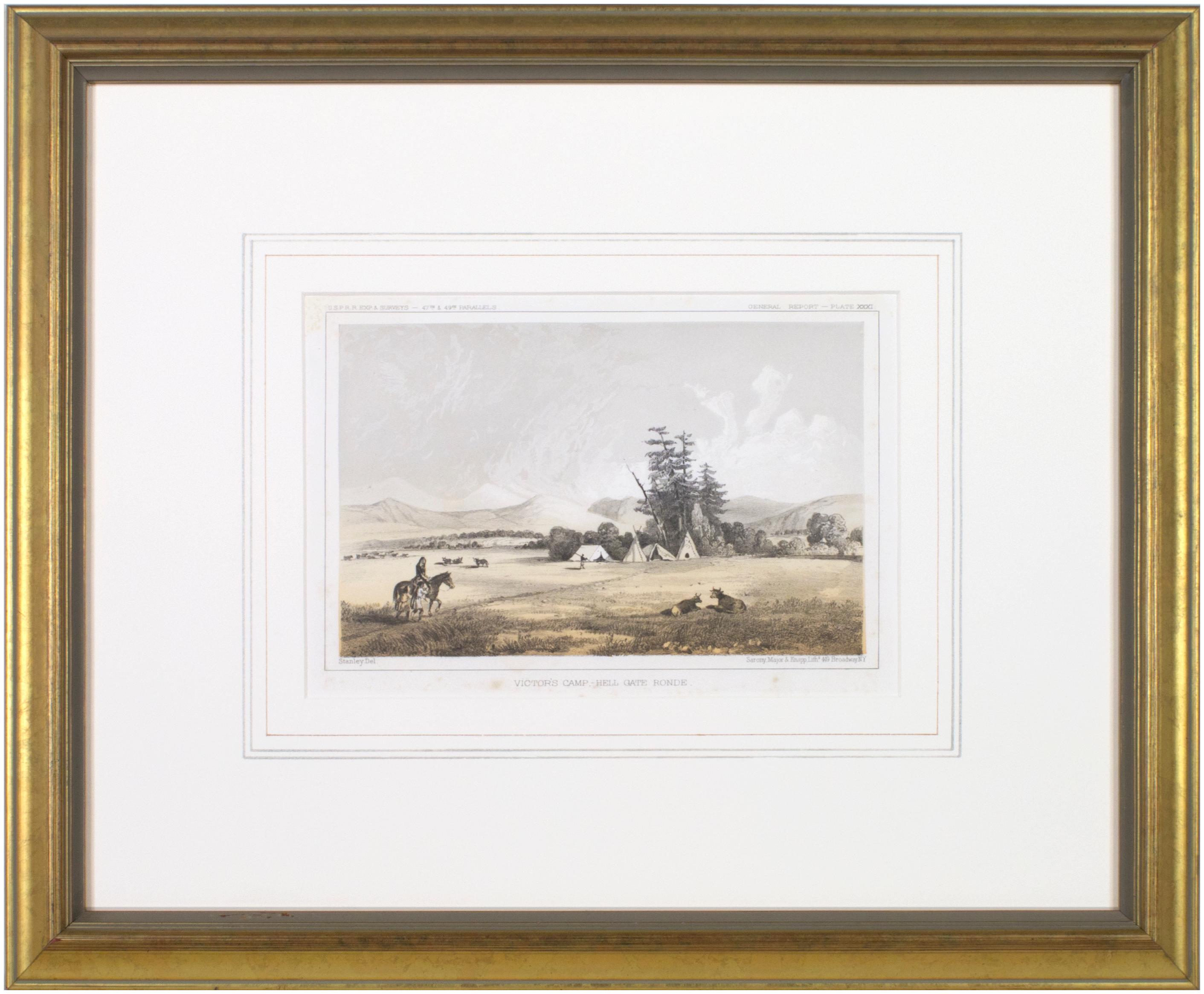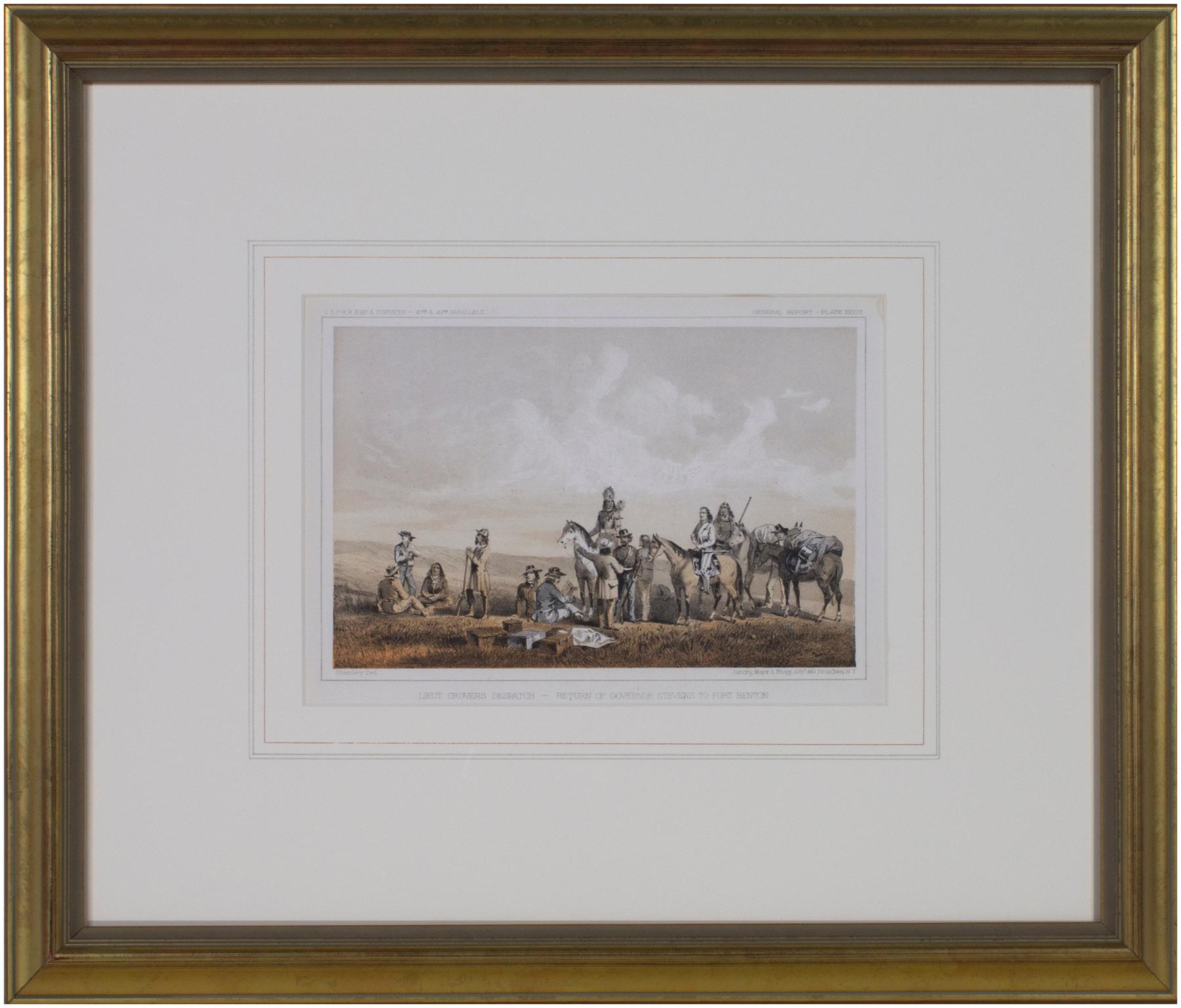Items Similar to L'ACTEUR . . . . - On voit bien qu'il fait chaud . . . . . . . trois spectateurs
Want more images or videos?
Request additional images or videos from the seller
1 of 8
Honoré DaumierL'ACTEUR . . . . - On voit bien qu'il fait chaud . . . . . . . trois spectateurs1856
1856
About the Item
L'ACTEUR . . . . - On voit bien qu'il fait chaud . . . . . . . trois spectateurs dans la salle ..... faut-il commencer ? . . . .
LE DIRECTEUR .- Et encore un des trois est le vendeur D'ENTRACTES . . . . . faites lever le rideau tout de suite avant qu'il
Lithograph, 1856
Signed with the artist's initials in the stone lower left
(see photo)
Series: PARIS L'ÉTÉ, plate 1, PARIS L'ÉTÉ. (Summer in Paris) is a series consisting of 5 prints which appeared in May 1852, in August 1854 and in June 1856 in the Charivari.
Published in: Le Charivari, 16.06.1856
Publisher: Destouches, Paris
Signed and inscribed by the publisher/printer Destouches in the lower right corner. (see photo)
Note: A rare "sur blanc" impression printed on thin vellum mince paper (not the usual wove paper), with inscription in ink for the justification of printing (BAT) signed by the printer Destouches lower right corner.
Condition: Very good for a Romantic lithograph
Image size: 7 7/8 x 10 1/4"
Sheet size: 11 x 14 1/2 inches
Reference: Delteil 2826 ii/III, with letters
Delteil documents this state as VERY RARE
Provenance: Henri M. Petiet, Paris, Lugt 5031 on the reverse
- Creator:Honoré Daumier (1808 - 1879, French)
- Creation Year:1856
- Dimensions:Height: 7.88 in (20.02 cm)Width: 10.25 in (26.04 cm)
- Medium:
- Movement & Style:
- Period:
- Condition:
- Gallery Location:Fairlawn, OH
- Reference Number:
Honoré Daumier
Honoré-Victorin Daumier is a French printmaker, caricaturist, painter and sculptor, whose many works offer commentary on the social and political life of 19th-century France. Daumier is famous for this satirical commentary through the lithographs he produced. He is best known for his caricatures of political figures. Daumier’s works are found in many of the world’s leading art museums, including the Louvre, the Metropolitan Museum of Art and the Rijksmuseum.
About the Seller
5.0
Recognized Seller
These prestigious sellers are industry leaders and represent the highest echelon for item quality and design.
Platinum Seller
These expertly vetted sellers are 1stDibs' most experienced sellers and are rated highest by our customers.
Established in 1978
1stDibs seller since 2013
718 sales on 1stDibs
Typical response time: 1 hour
Associations
International Fine Print Dealers Association
- ShippingRetrieving quote...Ships From: Akron, OH
- Return PolicyA return for this item may be initiated within 10 days of delivery.
More From This SellerView All
- Passage du Mont Saint-BernardBy Jean Louis Andre Theodore GericaultLocated in Fairlawn, OHTheodore Gericault (1791-1824) Passage du Mont Saint-Bernard Lithograph, 1822 Signed and titled in the stone As published in Arnault "Vie politique et militair...Category
1820s Romantic Figurative Prints
MaterialsLithograph
- Napoleon a BautzenBy Hippolyte BellangéLocated in Fairlawn, OHNapoleon a Bautzen Lithograph, 1822 Signed in the stone (see photo) From: Arnault, A. V. Vie Politique et Militaire de Napoleon (120 plates) Published, Paris, Librairie Historiquem 1...Category
1820s Romantic Figurative Prints
MaterialsLithograph
- Napoleon StandingLocated in Fairlawn, OHNapoleon Standing Lithograph, 1822 Signed in the stone lower left corner of image (see photo) From: Arnault, A. V. Vie Politique et Militaire de Napoleon (120 plates) Published, Paris, Librairie Historiquem 1822 Printed by C. Motte, Paris Considered to be the major pictorial treatise on Napoleon and his military conquests. Image size: 14 x 9 3/4 inches Sheet size: 23 5/8 x 17 3/4 inches Condition: Very good Horizontal prints...Category
1820s Romantic Figurative Prints
MaterialsLithograph
- Phrosine and MélidoreLocated in Fairlawn, OHPhrosine and Mélidore Etching, 1879 Signed in the polate lower left of image This etching is after the Dantan painting, a copy after the Pierre-Paul Prud’hom painting Published by Vve. A. Cadart, 56, Bard. Haussman, Paris A deluxe impression with masked letters The Prud’hom painting is in the Musée des Beaux-AÉdouard Joseph Dantan was born on 26 August 1848 in Paris. His grandfather, who had fought in the Napoleonic Wars, was a wood sculptor. His father, Antoine Laurent Dantan, and uncle, Jean-Pierre Dantan, were both well-known sculptors.[1] Dantan was a pupil of Isidore Pils and Henri Lehmann at the École nationale supérieure des Beaux-Arts in Paris.[2] At the age of nineteen he won a commission for a large mural painting of The Holy Trinity for the Hospice Brezin at Marne (Seine-et-Oise).[3] Dantan's first exhibit at the Paris Salon was An Episode in the Destruction of Pompeii in 1869. In 1870 the Franco-Prussian War interrupted his work, and he enlisted in the defence force.[4] He was given the rank of a sergeant, and was later promoted to lieutenant.[5] During the war the family home was burned down.[4] In the years after the war Dantan exhibited a number of other paintings at the Salon including Hercules at the Feet of Omphale (1874), Death of Tusaphane (1875), The Nymph Salmacis (1876), Priam Demanding of Achillees the Body of Hector (1877), Calling of the Apostles Peter and Andrew (1878), Corner of a Studio (1880) and The Breakfast of the Model (1881).[3] He continued to exhibit at the Salon until 1895. In 1890, 1894 and 1895 he served on the jury of the Salon. For twelve years Dantan's companion was the model Agostina Segatori, who had also posed for artists such as Jean-Baptiste Corot, Jean-Léon Gérôme, Eugène Delacroix and Édouard Manet. She bore a child to Dantan, Jean-Pierre, in 1873. On their separation, Agostina opened Café du Tambourin on the Boulevard de Clichy that became a meeting place for artists.[6][fn 1] Dantan spent his summers in Villerville, where he died on 9 July 1897 when the carriage in which he was riding crashed violently into the village church.[8] Style and reception Coin d'atelier (1880) At the 1870 exposition of the Ecole Nationale des Beaux-Arts Dantan received an honorable mention for his submission for the prix de Rome.[9] In 1874 he won a third class medal for his painting of a monk carving a Christ in wood...Category
1870s Romantic Figurative Prints
MaterialsEtching
- A Cart RaceBy Thomas RowlandsonLocated in Fairlawn, OHA Cart Race Hand colored etching & aquatint, 1788 Signed in the plate (see photo) Published by William Hollande, London Inscribed in the plate with title, artist's name and publication line 'Rowlandson. 1788./ London. Pubd 1789 by Wm Holland No 50. Oxford Street.' Reference: M.Dorothy George, 'Catalogue of Political and Personal Satires in the British Museum', VI, 1938) British Museum Satires 7607 Grego, 'Rowlandson', i. 260, Grego II.392 Provenance: Chris Beetles Ltd., London (label), 2003 Jeffrey M. Kaplan, Washington, D.C. (label) Condition: Excellent Archival framing by Chris Beetles Ltd., London Note: The British Museum has two impressions, one trimmed the other full sheet as this example. Accession Number: 1868,0711.35 The Metropolitan Museum has an impression: Accession number 59.533.314 Fitzwilliam Museum: Accession number: 34.14-286 Cleveland Museum of Art accession number: 1958.10 Image description per BM: Three ramshackle two-wheeled carts drawn by wretched horses race (right to left) against a background formed by the church... Note: The British Museum has two impressions, one trimmed the other full sheet as this example. Accession Number: 1868,0711.35 The Metropolitan Museum has an impression: Accession number 59.533.314 Fitzwilliam Museum: Accession number: 34.14-286 Cleveland Museum of Art accession number: 1958.10 Image description per BM: Three ramshackle two-wheeled carts drawn by wretched horses race (right to left) against a background formed by the clouds of dust which they have raised, with a row of gabled houses (right) inscribed 'St Giles', terminating in a church spire (left), and probably representing Broad St. Giles. The occupants of the carts are Irish costermongers typical of St. Giles. The foremost horse gallops, urged on by the shouts of a standing man brandishing a club. The other occupants, two women and a man, cheer derisively the next cart, whose horse has fallen, one woman falling from it head-first, another lies on the ground. The driver lashes the horse furiously. The third cart, of heavier construction, is starting. The horses are partly obscured by the clouds of dust, but denizens watch from casement windows and a door. Two ragged urchins (right) cheer the race; a dog barks. "It was said that the amount of copper Thomas Rowlandson etched would sheathe the British Navy. An inveterate gambler, for much of his life Rowlandson had to produce a flood of his comic prints to stay ahead of financial losses.A wealthy uncle and aunt raised Rowlandson after his textile-merchant father went bankrupt. His career developed quickly. He entered London's Royal Academy Schools in 1772, visited Paris in 1774, exhibited at the Royal Academy in 1775, and won a silver medal in 1777. He left school in 1778 to set up in business. Rowlandson's depictions of life in Georgian England exposed human foibles and vanity with sympathy and rollicking humor. During the 1780s he consolidated the delicate style he used for his coarse subjects. He worked mainly in ink and watercolor, his rhythmic compositions, flowing line, and relaxed elegance inspired by French Rococo art...Category
1780s Romantic Figurative Prints
MaterialsAquatint
- RenouveauBy Émile BerchmansLocated in Fairlawn, OHRenouveau Color lithograph, 1897 Signed in the stone lower right (see photo) Published in L’Estampe Moderne with their blindstamp lower right corner, Lugt 2790, (see photo) Edition ...Category
1890s Art Nouveau Figurative Prints
MaterialsLithograph
You May Also Like
- Le maréchal flamand (The Flemish Blacksmith) — 19th Century French RomanticismBy Jean Louis Andre Theodore GericaultLocated in Myrtle Beach, SCThéodore Géricault 'Le maréchal flamand' (The Flemish Blacksmith) from the series ‘Etudes, de chevaux lithographiés,’ lithograph, 1822, 2nd state ...Category
1820s Romantic Animal Prints
MaterialsLithograph
- 'Horse Attacked by Tiger' — 19th-Century French RomanticismBy Jean Louis Andre Theodore GericaultLocated in Myrtle Beach, SCThéodore Géricault (after), 'Tigre dévorant un cheval' (Tiger Devouring a Horse), lithograph, 3rd state of 3, Clement 97, c. 1820. Lettered 'Volmar ...Category
1820s Romantic Animal Prints
MaterialsLithograph
- 'Mazeppa' — 19th-Century French RomanticismBy Jean Louis Andre Theodore GericaultLocated in Myrtle Beach, SCThéodore Géricault and Eugène Lami, 'Mazeppa' from the series 'Oeuvres de Lord Byron', lithograph, 1823, 2nd state of 3, Delteil 94. Rendered by Thé...Category
1820s Romantic Animal Prints
MaterialsLithograph
- 'Victor's Camp - Hell Gate Ronde' original John Mix Stanley lithographBy John Mix StanleyLocated in Milwaukee, WIIn the mid-nineteenth century, the United States government set out to survey and document its newly acquired lands and territories west of the Mississippi. The goals of these surveys were manifold: to produce topographical maps, to document flora and fauna, and to document natural resources to build the emerging US economy. These surveys, and the images from them, also functioned to build the new sense of American identity with the landscape, condensing vistas into the 'picturesque' tradition of European image making. Thus, the entire span of US territory could be seen as a single, cohesive whole. This lithograph comes from one of six surveys commissioned by the Army's Topographic Bureau in 1853, which sought to find the best route to construct a transcontinental railroad. The result was a thirteen-volume report including maps, lithographs, and technical data entitled 'Explorations and Surveys to ascertain the most practicable and economical route for a Railroad from the Mississippi river to the Pacific Ocean.' In particular, the print comes from the northern survey, commanded by Isaac Stevens, which explored the regions between the 47th and 49th parallels. Stanley shows here the stop the Stanley Party made at the junction of the Bitterroot and Hell Gate, in present day Montana. While there, the Party met with the Flathead Chief by the name Victor, as is shown in the image. The figures and their encampment are dwarfed by the vast landscape around them, indicating the sublimity of these new American territories. 5.75 x 8.75 inches, image 6.5 x 9.25 inches, stone 17 x 20 inches, frame Artist 'Stanley Del.' lower left Entitled 'Victor's Camp - Hell Gate Ronde' lower center margin Publisher 'Sarony, Major & Knapp. Lith.s 449 Broadway N.Y.' lower right Inscribed 'U.S.P.R.R. EXP. & SURVEYS — 47th & 49th PARALLELS' upper left Inscribed 'GENERAL REPORT — PLATE XXXI' upper right Framed to conservation standards using 100 percent rag matting with French accents; glazed with UV5 Plexiglas to inhibit fading; housed in a gold reverse ogee moulding. Print in overall good condition; some localized foxing and discoloration; minor surface abrasions to frame. John Mix Stanley...Category
1850s Romantic Landscape Prints
MaterialsLithograph
- 'Lieutenant Crovers Despatch – Return of Governor Stevens to Fort Benton'By John Mix StanleyLocated in Milwaukee, WIIn the mid-nineteenth century, the United States government set out to survey and document its newly acquired lands and territories west of the Mississippi. The goals of these surveys were manifold: to produce topographical maps, to document flora and fauna, and to document natural resources to build the emerging US economy. These surveys, and the images from them, also functioned to build the new sense of American identity with the landscape, condensing vistas into the 'picturesque' tradition of European image making. Thus, the entire span of US territory could be seen as a single, cohesive whole. This lithograph comes from one of six surveys commissioned by the Army's Topographic Bureau in 1853, which sought to find the best route to construct a transcontinental railroad. The result was a thirteen-volume report including maps, lithographs, and technical data entitled 'Explorations and Surveys to ascertain the most practicable and economical route for a Railroad from the Mississippi river to the Pacific Ocean.' In particular, the print comes from the northern survey, commanded by Isaac Stevens, which explored the regions between the 47th and 49th parallels. 5.75 x 8.75 inches, image 6.5 x 9.25 inches, stone 17 x 20 inches, frame Artist 'Stanley Del.' lower left Entitled 'Lieutenant Crovers Despatch – Return of Governor Stevens to Fort Benton' lower center margin Publisher 'Sarony, Major & Knapp. Lith.s 449 Broadway N.Y.' lower right Inscribed 'U.S.P.R.R. EXP. & SURVEYS — 47th & 49th PARALLELS' upper left Inscribed 'GENERAL REPORT — PLATE XXXVII' upper right Framed to conservation standards using 100 percent rag matting with French accents; glazed with UV5 Plexiglas to inhibit fading; housed in a gold reverse ogee moulding. Print in overall good condition; some localized foxing and discoloration; minor surface abrasions to frame. John Mix Stanley...Category
1850s Romantic Landscape Prints
MaterialsLithograph
- 'Distribution of Goods to the Gros Ventres' lithograph by John Mix StanleyBy John Mix StanleyLocated in Milwaukee, WIIn the mid-nineteenth century, the United States government set out to survey and document its newly acquired lands and territories west of the Mississippi. The goals of these surveys were manifold: to produce topographical maps, to document flora and fauna, and to document natural resources to build the emerging US economy. These surveys, and the images from them, also functioned to build the new sense of American identity with the landscape, condensing vistas into the 'picturesque' tradition of European image making. Thus, the entire span of US territory could be seen as a single, cohesive whole. This lithograph comes from one of six surveys commissioned by the Army's Topographic Bureau in 1853, which sought to find the best route to construct a transcontinental railroad. The result was a thirteen-volume report including maps, lithographs, and technical data entitled 'Explorations and Surveys to ascertain the most practicable and economical route for a Railroad from the Mississippi river to the Pacific Ocean.' In particular, the print comes from the northern survey, commanded by Isaac Stevens, which explored the regions between the 47th and 49th parallels. In this image, Stanley documented the encounter with the Gros Ventre people at Milk River. The explorers were invited to the Gros Ventres camp and the two groups exchanged gifts in friendship. The Stevens Party provided "... blankets, shirts, calico, knives, beads, paint, powder, shot, tobacco, hard bread, etc." The image likewise alludes to how, in 1855, Isaac Stevens, concluded a treaty (Stat., L., XI, 657) to provide peace between the United States and the Blackfoot, Flathead and Nez Perce tribes. The Gros Ventres signed the treaty as part of the Blackfoot Confederacy, whose territory near the Three Fork area became a common hunting ground for the Flathead, Nez Perce, Kootenai, and Crow Indians. 5.75 x 8.75 inches, image 6.5 x 9.25 inches, stone 17 x 20 inches, frame Artist 'Stanley Del.' lower left Entitled 'Distribution of Goods to the Gros Ventres' lower center margin Publisher 'Sarony, Major & Knapp. Lith.s 449 Broadway N.Y.' lower right Inscribed 'U.S.P.R.R. EXP. & SURVEYS — 47th & 49th PARALLELS' upper left Inscribed 'GENERAL REPORT — PLATE XXI' upper right Framed to conservation standards using 100 percent rag matting with French accents; glazed with UV5 Plexiglas to inhibit fading; housed in a gold reverse ogee moulding. Print in overall good condition; some localized foxing and discoloration; minor surface abrasions to frame. John Mix...Category
1850s Romantic Landscape Prints
MaterialsLithograph
Recently Viewed
View AllMore Ways To Browse
Antique Sign Letters
De La Salle Paris
Daumier Lithographs
Romantic Iii
Honore Daumier Lithographs
Antique Ink Stone
Le Charivari
Antique Bat Print
Antique Print Of A Bat
Henri Blanc
Vintage French Opera Glasses
African Woman Head
Black And White Sketches Set
George Mine
German Expressionist Poster
Gucci 1977
Japanese Woodblock Print Antique Original Prints
Matisse Faces






